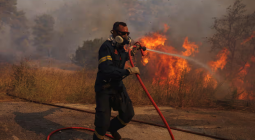Pollutionwatch: Dangers of adding rubbish to home fires
Tests show adding just 10% of waste to a wood burner indoors can double its particle pollution
It may be tempting to add cardboard, plastic, old clothing and other waste to your home fire to keep warm and save money. But a study has shown that burning waste indoors has serious consequences for air pollution and especially for the amount of cancer-causing chemicals in the air.
Stoves and fireplaces cause about 29% of PM2.5 particle pollution emitted in the UK, but there are even greater problems in eastern Europe, where solid fuel heating is responsible for more than 45% of the particle emissions in many cities.
Dr Dóra Mentes, a research fellow at the University of Miskolc, Hungary said: “The town where I live, Miskolc, is known to have some of the most polluted air in Europe. Every winter, everyone notices the poor air quality.”
The problem is augmented by burning waste at home. In Hungary, 2-10% of households also burn waste in their home heating boiler, while in Poland it is at least 10%. In the UK, at least 4% of homes that burn solid fuel indoors also burn rubbish on their fire, and one survey suggests this could be as high as 37%.
Mentes and her team set about investigating what home waste burning meant for air pollution. A typical home wood burner was installed in their laboratory with sensors and sampling equipment connected to the chimney.
First, the researchers tested the air pollution when oak logs were burned. They then tested mixtures of oak logs and 10% waste, including plastics, textiles (both cotton and polyester), cardboard and coated papers such as drinks cartons.
Cotton, cardboard and coated paper caused the biggest increases in the particle pollution in the chimney. In some cases, adding 10% waste doubled the particle pollution.
Mentes also looked at the size and shape of the pollution particles using a scanning electron microscope. She said: “They can take on many different shapes. My two favourites are tar-ball conglomerates and soot agglomerates associated with inorganic crystal particles. As dangerous as they are, they are also remarkably beautiful.”
Adding waste meant many more globules of tar going up the chimney, along with greater amounts of carbon monoxide.
Perhaps of greatest concern were cancer-causing polycyclic aromatic hydrocarbons. These increased by about two- to four times, depending on waste. Plastics and coated paper led to the biggest increases.
Modern municipal waste incinerators in the UK and Europe go to great lengths to reduce these toxic emissions but there are no protections when waste is burned at home.
Ironically, Mentes’ team found that adding waste reduced the efficiency of the wood stove. Adding plastics meant the wood burned too fast for the stove design, while paper and cotton clogged the air flow with ash. This meant that adding waste reduced the heat from the main fuel.
Problems with waste burning are not confined to eastern Europe. Air pollution in India’s cities often includes chemicals from burning waste and plastics. Globally, the climate impact of soot from open burning of waste is estimated to cause 2-10% of all carbon dioxide emissions.
Cover photo: By The Guardian




